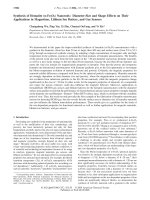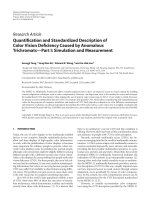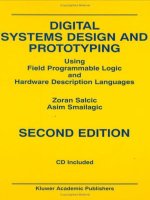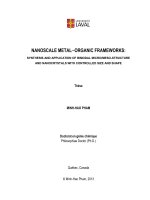Sketching and shape description
Bạn đang xem bản rút gọn của tài liệu. Xem và tải ngay bản đầy đủ của tài liệu tại đây (2.91 MB, 57 trang )
TED 105: Communicating
Technical Designs
• Sketching and Shape Description
– Straight Lines
– Circles and Arcs
– Proportions
– Generating Technical Designs
Purpose
• The main purpose of sketching is to
convey ideas. Engineers have to use
sketches to brainstorm ideas, as well as,
to show others what they are working on
or what should be designed. Sketches are
also used to document measurements
from the field before they are produced as
solid models on the computer.
Freehand Sketching
• Most original designs are first expressed
on medium as a freehand sketch.
• Used for:
– Amplifying and clarifying
– Recording
verbal explanations
Technical Sketching
• Engineers’ view: ability to render
serviceable sketches greater value than
skill to create instrument drawings
• Freehand sketch should not mean crude
and sloppy
• Freehand sketch should be made with
care and attention to proportion, clarity,
and line widths.
Types of Sketches
Scale
• Typically not made to any scale.
• Correct proportions are needed.
• Size of sketch:
– Optional
– Determined by:
• Complexity of object
• Size of paper
• Small objects may be enlarged to show
details clearly.
Do you want to be a good
sketcher?
Purpose
• Proper documentation in a notebook is
essential. When proper documentation is
made, ideas are not lost and projects can
be duplicated. The sketch on the next
slide is a sample from a notebook where a
sketch was made and notes as well as
dimensions have been documented.
Proposed Notebook Sample
Size requirements.
Shows design details
Title
Initialed and dated.
Sketching Techniques
• Line Types:
Vertical Line
Horizontal Line
Inclined Line
Sketching Techniques
• Finding the slope angle of an inclined line:
Equation:
tans = RISE/RUN
Run = 4
Rise = 2
Note: Rise and Run units
do not matter (As long as the
units are the same). You are
finding an angle. In the above
case, we are counting grid boxes.
tans = 2/4
tans = .5
s = arctan .5
s 27
Sketching Techniques
• Sketching a Line.
Sketching Techniques
• Sketching an Arc
1) Draw intersecting
lines
2) Mark off
equal distances.
3) Draw line between
marks.
Sketching Techniques
• Sketching an Arc
4) Draw center mark.
5) Make the arc.
Sketching Techniques
• Sketching a Circle
1) Setup the
diameter
2) Square in the
diameter
3) Sketch
diagonals
Sketching Techniques
• Sketching a Circle
4) Identify triangle
centers
5) Sketch arcs
Size and Proportion
• Although you have learned to draw lines and arcs, you
can not communicate properly until you understand how
to sketch with the correct size and proportion. Without
proper size and proportion your sketch will not look right.
• Size: Length, width, height, distance. How big is the
object you are sketching?
• Proportion: If two objects are five feet apart in real life,
then those two objects must appear to be five feet apart
in your sketch.
Size and Proportion
• How to create proper size and proportion.
Technique I
– Using a pencil to measure.
Hold your pencil at arms
length as you see in Figure 2.
Use the top of the pencil and
your thumb as a distance for
the height of the window. This
distance will be used as a
reference for sketching the rest
of the house as we did in the
house on the next slide.
Figure 2
Size and Proportion
• How to create proper size and proportion.
Technique I
– Using a pencil to measure.
As you see in the completed
house in Figure 3, the units
of the numbered dimensions
are in windows.
You should also notice that
the use of graph paper also
helps in creating proper size
and proportion.
Figure 3
Size and Proportion
• How to create proper size and proportion.
Technique II
– Boxing in the sketch.
In Figure 4 we are sketching
a chair. We sketch the boxes
to the largest outside
dimensions of our final
object. Notice that light
construction lines are also
used to help guide us to
the proper size and
proportion.
Figure 4
Size and Proportion
• How to create proper size and proportion.
Technique II
– Boxing in the sketch.
Finally we use our sketching
techniques for drawing arcs,
lines and circles to complete
our chair in Figure 5.
Notice the box we started
with is still existent as light
construction lines. These are
our guides for proportion and
size.
Figure 5
Alphabet of Lines
Alphabet of Lines
Short Break Line: A freehand
Object Line: Thick lines
Hidden Line: Lines used to
drawn line that shows where a part is
about .6mm(.032in) that show
show interior detail that is not visible
broken to reveal detail behind the part or
the visible edges of an object.
Center
Line: Lines
from
the outside
of thethat
part.define
to shorten a long continuous part. (See
Section
Lines are
used to
the center
of Lines:
arcs, circles,
or symmetrical
parts. of Long Break Line
example
define
there
material
They
arewhere
half as
thickis as
an object line. on the next slide.)
after a part of the object is cut away.
Construction Line: Very lightly
drawn lines used as guides to help draw
all other lines and shapes properly.
Usually erased after being used.
Alphabet of Lines
Dimension
Lines
that
used
to A line used to
Cutting
Plane
Line:
Long Break
Lines:Lines:
Break
lines
areare
used
are
drawn
on
designate
where
a part has been cut
to either show
show distance.
detail or asArrows
in this
case
they
canthe
Extension
Lines:
Lines
used
to
show
where
ends
show
where
the
dimension
starts
and
ends.
away
toline
see
detail.
The
arrows should
be to
used
to shorten
very
long
objects
that
achange
dimension
starts
and located
stops
an
object.
The
actual
distance
is usually
inthe
the
middle of
this
point
in
direction
that
you are
do not
in detail.
Notice
that on
this
part
with
dimension
lines
properly
dimension
lineisUsed
to
letlong
you however
know
thewe
distance
being
communicated.
looking
at the cutout.
12”
havetoshortened
object. with
The
line
1/16”to
from the
Dimension
lines
areislines
used
inaway
conjunction
thean
drawing
break
use
part as
notextension
get
confused
the object lines
with
lineswith
to properly
ourto
space
more
efficiently.
dimension objects.
Leader Lines: Leader lines are used to
show dimensions of arcs, circles and to help
show detail. An arrow head is used to point
to the part you are dimensioning and the line comes
off the arrow point usually at a 45 degree angle.
At the end of this line a horizontal line is drawn
with a note at the end telling information
How many lines from the
about what is being pointed at.
previous slide can you identify
here?
Alphabet of lines
Phantom Lines: Phantom lines are used
to identify alternate positions that a part my
take up. In this example we are using Phantom
lines to show that the door handle may only move
45 degrees from it’s horizontal
position.
How many lines from the
previous 2 slides can you
identify here?









